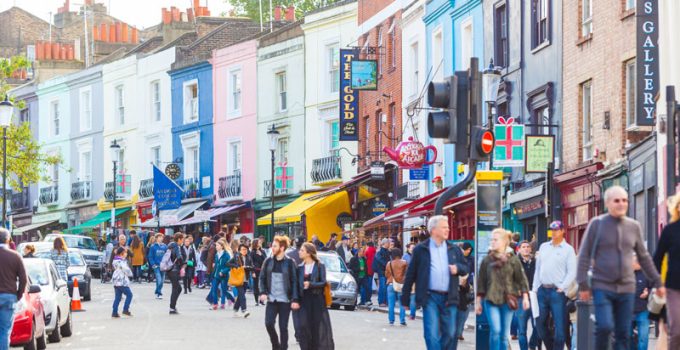Ladbroke Grove, nestled in the Royal Borough of Kensington and Chelsea, is one of West London’s most vibrant and culturally rich areas. Known for its bohemian charm, diverse community, and historic significance, Ladbroke Grove has long been a hub of artistic expression, cultural fusion, and social activism. This article explores the history, cultural landmarks, notable residents, and contemporary significance of Ladbroke Grove.
Contents
Historical Background Ladbroke Grove

Ladbroke Grove derives its name from James Weller Ladbroke, a prominent 19th-century landowner who developed the area. The Ladbroke family owned much of the land in the early 1800s, and their vision helped shape the neighborhood’s distinctive character. The area was originally rural farmland but underwent significant development during the mid-19th century, transforming into a residential district with elegant terraced houses and communal gardens.
The construction of the Grand Union Canal in the early 19th century also played a crucial role in the area’s development, facilitating trade and attracting workers. By the late 19th and early 20th centuries, Ladbroke Grove had evolved into a bustling urban neighborhood, characterized by a mix of grand Victorian houses and more modest worker’s cottages.
Cultural Melting Pot
Ladbroke Grove is renowned for its cultural diversity, which is reflected in its vibrant community and lively atmosphere. Over the decades, it has attracted people from various ethnic backgrounds, creating a rich tapestry of cultures and traditions.
Caribbean Influence
One of the most significant cultural influences in Ladbroke Grove is the Caribbean community. During the post-World War II period, many Caribbean immigrants settled in the area, contributing to its multicultural fabric. This influx of Caribbean culture is most famously celebrated during the Notting Hill Carnival, one of the world’s largest street festivals.
The Notting Hill Carnival, held annually in August, showcases Caribbean music, dance, and cuisine, drawing millions of visitors from around the globe. The event features vibrant parades, live music performances, and an array of food stalls, transforming Ladbroke Grove into a kaleidoscope of color and sound.
Artistic Hub
Ladbroke Grove has long been a magnet for artists, musicians, and creatives. In the 1960s and 1970s, the area became synonymous with the countercultural movement, attracting influential figures from the music and art scenes. Notable artists and musicians, including members of The Rolling Stones and Pink Floyd, lived and worked in the area, further cementing its reputation as an artistic enclave.
The area’s bohemian spirit is still evident today, with numerous art galleries, studios, and cultural spaces dotting the landscape. Ladbroke Grove continues to inspire and nurture creative talent, making it a vital part of London’s cultural scene.
Notable Landmarks Ladbroke Grove

Ladbroke Grove boasts several notable landmarks that reflect its rich history and cultural significance.
Portobello Road Market
One of the most famous landmarks in Ladbroke Grove is Portobello Road Market. Stretching over two miles, this bustling market is a must-visit destination for locals and tourists alike. It is renowned for its eclectic mix of antiques, vintage clothing, fresh produce, and street food. The market’s vibrant atmosphere and diverse offerings make it a quintessential part of the Ladbroke Grove experience.
Portobello Road Market dates back to the 19th century and has grown to become one of London’s most iconic markets. Each day of the week has a different focus, with Saturdays being the busiest and most popular day for antique hunters and shoppers.
Trellick Tower
Trellick Tower is another prominent landmark in Ladbroke Grove. Designed by the renowned architect Erno Goldfinger and completed in 1972, this iconic Brutalist high-rise is a striking example of post-war architectural design. Initially controversial, Trellick Tower has since gained recognition as an architectural masterpiece and a symbol of the area’s urban landscape.
The tower stands at 31 stories high and features distinctive design elements, such as its concrete facade and external service tower. Trellick Tower has been granted Grade II* listed status, highlighting its architectural and historical significance.
St. John’s Church
St. John’s Church, located on Lansdowne Crescent, is a historic church that serves as a focal point for the community. Built in the mid-19th century, the church is known for its beautiful Gothic Revival architecture and serene atmosphere. St. John’s Church hosts various community events and services, contributing to the social fabric of Ladbroke Grove.
Contemporary Significance
In recent years, Ladbroke Grove has continued to evolve, balancing its historic charm with modern development. The area remains a desirable place to live, work, and visit, attracting a diverse mix of residents and visitors.
Residential Appeal
Ladbroke Grove’s residential appeal lies in its unique blend of architectural styles, from elegant Victorian terraces to contemporary apartments. The area’s communal gardens, such as Ladbroke Square Garden and Arundel Gardens, offer tranquil green spaces for residents to enjoy. These gardens provide a sense of community and enhance the quality of life in Ladbroke Grove.
The area’s property market has seen significant growth, with rising demand for both rental and owner-occupied homes. Despite this growth, efforts have been made to preserve the area’s historical character and cultural heritage.
Community Initiatives
Ladbroke Grove is home to numerous community initiatives and organizations that work to support and uplift the local community. These initiatives address various social issues, including housing, education, and youth empowerment.
One notable organization is the Westway Trust, a charity that manages the land and facilities under the Westway flyover. The Trust provides community spaces, supports local businesses, and runs programs that benefit the residents of Ladbroke Grove. Their efforts help to foster a strong sense of community and promote social cohesion.
Transportation and Connectivity

Ladbroke Grove is well-connected to the rest of London, making it an attractive location for commuters. The Ladbroke Grove Underground Station, served by the Circle and Hammersmith & City lines, provides easy access to central London and other key destinations. Additionally, several bus routes and the nearby Westway A40 motorway ensure convenient transportation options for residents and visitors.
Notable Residents
Ladbroke Grove has been home to many notable residents over the years, contributing to its cultural and social significance.
Joe Strummer
Joe Strummer, the legendary frontman of The Clash, lived in Ladbroke Grove during the height of the punk rock movement. Strummer’s presence in the area added to its reputation as a hub of musical innovation and rebellion. His influence is still felt today, with murals and tributes honoring his legacy.
Damon Albarn
Damon Albarn, the lead singer of Blur and co-creator of Gorillaz, is another fatcai login prominent figure associated with Ladbroke Grove. Albarn’s creative endeavors and contributions to the music industry have further solidified the area’s status as an artistic and cultural hotspot.
Iris Murdoch
Renowned novelist and philosopher Iris Murdoch also lived in Ladbroke Grove. Her intellectual and literary contributions have left a lasting impact on the area’s cultural heritage. Murdoch’s works continue to be celebrated and studied by literature enthusiasts worldwide.
Conclusion
Ladbroke Grove is a dynamic and culturally rich area that embodies the spirit of diversity, creativity, and community. From its historic landmarks and bustling markets to its vibrant arts scene and welcoming community, Ladbroke Grove offers a unique and enriching experience for residents and visitors alike. As the area continues to evolve, it remains a testament to the enduring appeal and cultural significance of this corner of West London.
Read More Article About “Audrey Davis: An Emerging Leader in Environmental Conservation“




